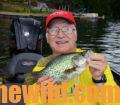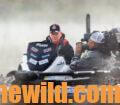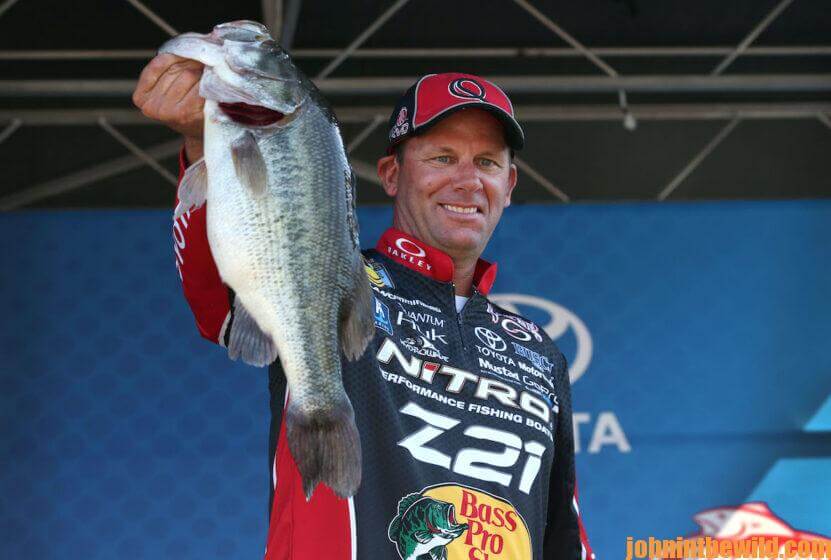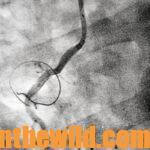Editor’s Note: Kevin VanDam of Kalamazoo, Michigan has won the Bassmaster’s Classic four times and has been named Angler of the Year seven times. VanDam knows how to fish for bass and catch them in bad weather.
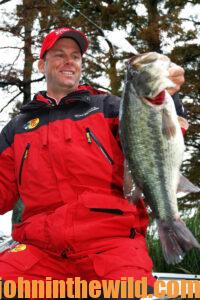 Question: Kevin, can you give me some tactics for bass fishing in bad weather?
Question: Kevin, can you give me some tactics for bass fishing in bad weather?
Answer: When you fish bass tournaments, you have to fish regardless of the weather and water conditions. I’ve caught plenty of nice bass on days I ordinarily wouldn’t have fished if I hadn’t had to fish a tournament. The first day a cold front or a storm front hits can be an exceptionally- good day to catch plenty of bass. Although the air temperature may have dropped dramatically, the water temperature only may have fallen slightly. That small change in water temperature often will cause bass to go on a feeding spree.
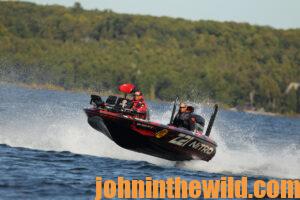 The day a front hits, I want to locate as many big schools of bass as I can, as fast as I can. To accomplish this, I’ll cast a deep-running Strike King crankbait ( https://www.strikeking.com/). I’ll fish this lure along rocky banks or steep drop-offs with some wave action that forces the fish into the bank. During a temperature change, even if the temperature drops, the big bass will move out of deep water and begin to chase shad, possibly to feed up for those cold-weather conditions. By covering as much water as possible on the day the front moves through an area, I usually can locate the places holding the most and the biggest bass.
The day a front hits, I want to locate as many big schools of bass as I can, as fast as I can. To accomplish this, I’ll cast a deep-running Strike King crankbait ( https://www.strikeking.com/). I’ll fish this lure along rocky banks or steep drop-offs with some wave action that forces the fish into the bank. During a temperature change, even if the temperature drops, the big bass will move out of deep water and begin to chase shad, possibly to feed up for those cold-weather conditions. By covering as much water as possible on the day the front moves through an area, I usually can locate the places holding the most and the biggest bass.
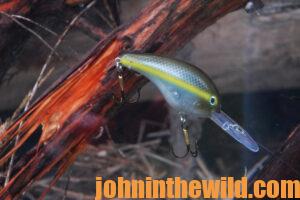 To keep my bait in the bass’ strike zone for the longest time, I’ll cast parallel to the bank. If the water has stain in it, the bass generally will hold 4-8 feet deep. But in clear water, you may find the bass from 10-15 feet deep. I prefer to fish 8-10 pound test line and crankbaits with tight wobbles and no rattles. These kinds of lures can slow your retrieve down, but the bait still will wiggle quite a bit as it comes through the water. Sometimes I’ll add weight to a crankbait to allow me to crawl it along the bottom very slowly. On other days, the bass may like to take a bait with a fast retrieve, stop, fast retrieve, stop type of presentation. Remember that at this time of year in the early spring, crayfish are the bass’ primary diet. I want to fish my crankbaits in the browns, reds or even black to look more like the crayfish on which the bass will feed. Or, I’ll use shad-colored crankbaits. If you’re fishing a lake with no rocky banks or sheer rock bluffs, then you can use this crankbait technique on creek or river channels in bad weather.
To keep my bait in the bass’ strike zone for the longest time, I’ll cast parallel to the bank. If the water has stain in it, the bass generally will hold 4-8 feet deep. But in clear water, you may find the bass from 10-15 feet deep. I prefer to fish 8-10 pound test line and crankbaits with tight wobbles and no rattles. These kinds of lures can slow your retrieve down, but the bait still will wiggle quite a bit as it comes through the water. Sometimes I’ll add weight to a crankbait to allow me to crawl it along the bottom very slowly. On other days, the bass may like to take a bait with a fast retrieve, stop, fast retrieve, stop type of presentation. Remember that at this time of year in the early spring, crayfish are the bass’ primary diet. I want to fish my crankbaits in the browns, reds or even black to look more like the crayfish on which the bass will feed. Or, I’ll use shad-colored crankbaits. If you’re fishing a lake with no rocky banks or sheer rock bluffs, then you can use this crankbait technique on creek or river channels in bad weather.
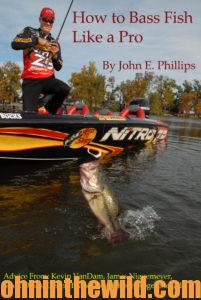 To learn more about bass fishing, check out John E. Phillips’ book, “How to Bass Fish Like a Pro,” available in Kindle, print and Audible versions at https://www.amazon.com/gp/product/B007RP2LZS/ref=dbs_a_def_rwt_hsch_vapi_taft_p2_i2
To learn more about bass fishing, check out John E. Phillips’ book, “How to Bass Fish Like a Pro,” available in Kindle, print and Audible versions at https://www.amazon.com/gp/product/B007RP2LZS/ref=dbs_a_def_rwt_hsch_vapi_taft_p2_i2
You may have to copy and paste this click into your browser. When you click on this book, notice on the left where Amazon says you can read and hear 10% of the book for free. On the right side of the Audible page for this book and below the offer for free Audible trial, you can click on Buy the Audible with one click.
Tomorrow: Kevin VanDam Bass Fishes after Fronts

